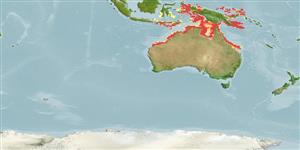分類 / Names
俗名 | 同種異名 | Catalog of Fishes(屬, 種) | ITIS | CoL | WoRMS | Cloffa
Elasmobranchii
板鰓亞綱 (鯊魚與魟魚) (sharks and rays) >
Orectolobiformes (Carpet sharks)
鬚鯊目 (Carpet sharks) >
Orectolobidae (Carpet or nurse sharks)
鬚鮫科 (Carpet or nurse sharks)
Etymology: Eucrossorhinus: eu (Gr.), very; Crossorhinus (=Orectolobus), previous genus, from krossos (Gr.), fringe or tassel, referring to tassel of dermal lobes fringing the head, and rhinus, an ancient name for sharks, from rhine (Gr.), rasp, alluding to their rasp-like skin, or rhinos, snout, referring to “lobe-like attachments from the nose” (translation, from Müller & Henle’s 1837 description of Crossorhinus). (See ETYFish); dasypogon: dasys (Gr.), hairy; pogon (Gr.), beard, referring to dense beard-like tassel of dermal lobes fringing the head. (See ETYFish).
More on author: Bleeker.
Environment: milieu / climate zone / depth range / distribution range
生態學
海洋 礁區魚類; 深度上下限 2 - 50 m (Ref. 106604). 深水域; 1°N - 23°S, 115°E - 155°E
Indo-West Pacific: eastern Indonesia, Papua New Guinea, and northern Australia (including Barrow Island, Western Australia). Questionable occurrence in Malaysia.
西太平洋: 印尼東部,巴布亞新幾內亞與澳洲北部 (包括澳洲西部的 Barrow 島). 在馬來西亞的可疑發生。
大小 / 重量 / 年齡
Maturity: Lm ? range ? - ? cm
Max length : 366 cm TL 雄魚/尚未辨別雌雄; (Ref. 90102); common length : 180 cm TL 雄魚/尚未辨別雌雄; (Ref. 90102)
背棘 (總數): 0; 背的軟條 (總數): 0; 臀棘 0; 臀鰭軟條: 0. Body with a reticular pattern of narrow dark lines (Ref. 13577). Caudal fin with its upper lobe hardly elevated above the body axis, with a strong terminal lobe and subterminal notch but no ventral lobe (Ref. 13577).
身體有一個狹窄黑色線條的網狀圖案.(參考文獻 13577) 尾鰭上葉並不高的上方體軸, 具有一個強韌的端葉與接近端位的凹槽但是沒有腹的葉.(參考文獻 13577)
A little-known shark (Ref. 247) found on the continental shelf and offshore reefs (Ref. 6871). Probably feeds on bottom fishes and invertebrates (Ref. 13577, 43278); also known to eat nocturnal teleost fishes such as squirrelfish and soldierfish (Holocentridae) and sweepers (Pempheridae) (Ref. 43278). Ovoviviparous (Ref. 50449). Might bite in self-defense or when mistaking a human foot for its usual prey (Ref. 247). Its tough skin sometimes used for leather (Ref. 13577). The maximum length of 366 cm TL reported for this species is uncertain (Ref. 247, 90102).
所知極少的鯊魚 (參考文獻 247) 發現於大陸棚與外海礁石了。 (參考文獻 6871) 可能吃底層魚類與無脊椎動物。 (參考文獻 13577) 卵胎生的.(參考文獻 50449) 可能在自我防衛中咬或當誤以為人類的腳是它的平常獵物的時候.(參考文獻 247) 它的硬皮有時作為皮革.(參考文獻 13577) 366 公分TL 的最大長度這個種的報告不確定.(參考文獻 247)
Life cycle and mating behavior
成熟度 | 繁殖 | 產卵場 | 卵 | 孕卵數 | 仔魚
Ovoviviparous, embryos feed solely on yolk (Ref. 50449).西太平洋: 印尼東部,巴布亞新幾內亞與澳洲北部 (包括澳洲西部的 Barrow 島). 在馬來西亞的可疑發生。
Compagno, L.J.V., 1984. FAO Species Catalogue. Vol. 4. Sharks of the world. An annotated and illustrated catalogue of shark species known to date. Part 1 - Hexanchiformes to Lamniformes. FAO Fish. Synop. 125(4/1):1-249. Rome, FAO. (Ref. 247)
IUCN 瀕危狀態 (Ref. 130435)
無危 (LC) ; Date assessed: 18 February 2015
人類使用
更多資訊
參考文獻養殖養殖資訊品種遺傳學Electrophoreses遺傳率疾病加工NutrientsMass conversion
合作者照片Stamps, Coins Misc.聲音神經毒速度泳型鰓區Otoliths腦重體重比眼睛色素
工具
特別的報告
下載 XML
網路資源
Estimates based on models
Preferred temperature (Ref.
123201): 26.2 - 28.8, mean 27.8 °C (based on 294 cells).
Phylogenetic diversity index (Ref.
82804): PD
50 = 1.0002 [Uniqueness, from 0.5 = low to 2.0 = high].
Bayesian length-weight: a=0.00389 (0.00180 - 0.00842), b=3.12 (2.94 - 3.30), in cm total length, based on all LWR estimates for this body shape (Ref.
93245).
營養階層 (Ref.
69278): 4.0 ±0.60 se; based on food items.
回復力 (Ref.
120179): 低的, 最小族群倍增時間4.5 - 14 年 (Fec assumed to be <100).
Fishing Vulnerability (Ref.
59153): Very high vulnerability (90 of 100).
Nutrients (Ref.
124155): Calcium = 1.57 [0.18, 7.23] mg/100g; Iron = 0.125 [0.027, 0.423] mg/100g; Protein = 19.4 [17.1, 21.6] %; Omega3 = 0.0936 [, ] g/100g; Selenium = 7.92 [2.19, 30.75] μg/100g; VitaminA = 13.4 [2.3, 84.0] μg/100g; Zinc = 0.248 [0.114, 0.523] mg/100g (wet weight);
